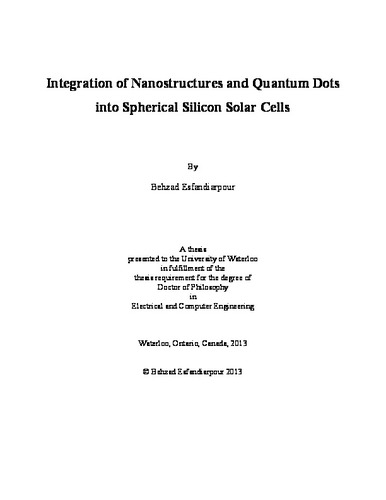| dc.contributor.author | Esfandiarpour, Behzad | |
| dc.date.accessioned | 2013-09-26 17:41:39 (GMT) | |
| dc.date.available | 2014-06-04 05:00:44 (GMT) | |
| dc.date.issued | 2013-09-26T17:41:39Z | |
| dc.date.submitted | 2013 | |
| dc.identifier.uri | http://hdl.handle.net/10012/7926 | |
| dc.description.abstract | In order to improve the optical losses of spherical silicon solar cells, new fabrication designs were presented. The new device structures are fabricated based on integration of nanostructures into spherical silicon solar cells. These new device structures include: spherical silicon solar cells integrated with nanostructured antireflection coating layers, spherical silicon solar cells with hemispherical nanopit texturing, and cells integrated with colloidal quantum dots.
Silicon spheres were characterized by means of transmission electron microscopy (TEM), single-crystal x-ray diffraction and x-ray powder diffraction to establish the crystallinity nature of the silicon spheres. Furthermore, the material properties of silicon spheres including surface morphology, microwave photoconductivity decay lifetime, and impurity elemental distributions were studied.
Silicon nitride antireflection coating layers were developed and deposited onto the spherical silicon solar cells, using a PECVD system. A low temperature hydrogenation plasma technique was developed to improve the passivation quality of the spherical silicon solar cells. The spectral response of silicon spheres with and without a silicon nitride antireflection coating was studied.
We have successfully developed and integrated a nanostructured antireflection coating layer into spherical silicon solar cells. The nanostructured porous layer consists of graded-size silicon nanocrystals and quantum-size Si nanoparticles embedded in an oxide matrix. This layer has been characterized by means of scanning electron microscopy (SEM), transmission electron microscopy (TEM), Scanning tunneling TEM, energy filtered TEM, transmission electron diffraction (TED), electron energy loss spectroscopy (EELS), energy dispersive x-ray (EDX), Raman spectroscopy and photoluminescence spectroscopy (PL).
We developed a novel technique of electrochemical etching for silicon surface texturing using a liquid-phase deposition of oxide mask. Using a focus ion-beam (FIB) technique, cross-sectional TEM samples were prepared to investigate the nature of texturing and the composition of the deposited mask. The hemispherical nanopit texturing was successfully integrated into spherical silicon solar cells and the etching mechanisms and the chemical reactions were discussed.
CdSe colloidal quantum dots with diameter of about 2.8nm were integrated into a graded-density nanoporous layer. This structure was implemented on the emitter of the spherical silicon solar cells and the spectral response with and without incorporation of QDs was studied. | en |
| dc.language.iso | en | en |
| dc.publisher | University of Waterloo | en |
| dc.subject | Silicon spheres | en |
| dc.subject | nanostructures | en |
| dc.subject | Quantum Dots | en |
| dc.subject | nanostructured antireflection coating | en |
| dc.subject | nanotexturing | en |
| dc.subject | Spherical Silicon Solar Cells | en |
| dc.title | Integration of Nanostructures and Quantum Dots into Spherical Silicon Solar Cells | en |
| dc.type | Doctoral Thesis | en |
| dc.pending | true | en |
| dc.subject.program | Electrical and Computer Engineering | en |
| dc.description.embargoterms | 1 year | en |
| uws-etd.degree.department | Electrical and Computer Engineering | en |
| uws-etd.degree | Doctor of Philosophy | en |
| uws.typeOfResource | Text | en |
| uws.peerReviewStatus | Unreviewed | en |
| uws.scholarLevel | Graduate | en |

